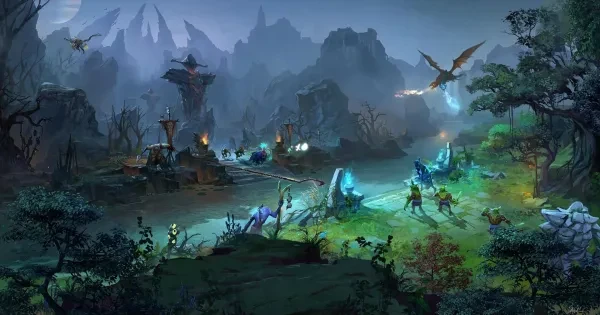PlayStation Plus Premium: Backwards Compatibility Performance Review
[ad_1]
Sony announced earlier this year that its PlayStation Plus subscription service and PlayStation Now streaming service would be merging into a single service. The new service, also called PlayStation Plus, has three subscription tiers: Essentials, Extra, and Premium. Essentials is predominantly the same as the older version of PlayStation Plus, with online multiplayer access, free monthly games, online cloud saves, and store discounts. Extra encompasses all these features but adds a curated catalog of nearly 400 PS4 and PS5 games you can download and play on your local console.
Premium is what we’re looking at today, which includes the previous two tiers as well as an additional catalog of PS3 games available via cloud streaming, PS2, PS1, and PSP games available for stream or download, and time-limited game trials.
Considering the PlayStation’s extensive collection of historic games, it’s impressive to see games from all prior PlayStation generations available here to play. But not all are equal.
PlayStation 3 Games on PlayStation Plus Premium
We shall start with the most challenging: the PlayStation 3 and its unique Cell CPU, which was and remains an exotic architecture thanks to its mixture of high bandwidth, Parallel SPU’s, PPU’s, and split memory from the RSX GPU. In short, the challenges to emulate this hardware locally are not insignificant. It remains a relatively powerful and customized architecture, providing developers a blank canvas to use and solve problems in a multitude of ways. This means that the methods deployed are not consistent on a game-by-game basis, and for some games local emulation at a playable level might not even be possible.
The solution Sony has taken is to incorporate PS3 emulation into its server-based rack solution, also known as Cloud Gaming. This means that, at least for now, local PS3 emulation is not possible. When you load up a PS3 game via PlayStation Plus, you’re accessing genuine Cell and RSX motherboards in a remote data center running the genuine PS3 code remotely, taking your inputs, parsing them to the local instance, and then streaming back the output as a normal video and audio stream to your PS4, PS5, or PC.
To assess this solution, I’m going to categorize it into 4 core levels. Using a later PlayStation 3 game, Motorstorm Apocalypse, let’s tackle these in order.
Ease and speed of use
The game is browsed and selected from the 100+ on offer now, in the exact same way as any other game across the service.
Select your game, click stream, wait for the VM to start, and enjoy your game. This is the fastest and simplest generation here from that perspective. No waiting for a download, approximately 1 minute access to a game and a quick change to another one if required. The ease and speed of the solution is excellent, and aside from any network issues or such, it really could not be more accessible – as good or better than it ever was on PlayStation Now.
Accuracy of Emulation to the original Hardware
Next is the Accuracy to the target hardware, and as I said before these are all run on real Cell hardware. While it’s not just a stack of PS3’s in a rack, they are at least the same architecture of the console and as such should be identical. And we see that in the outputs, with the OS UI, menus, inputs, and gameplay all a perfect replication of playing at home. The one difference is in loading times, which are significantly faster compared to loading off the PS3’s original Blu-ray disc, since in this case games are installed to HDDs or SANs at the remote Sony servers.
Visual issues affected or improvements offered
Visual accuracy is where we start seeing limitations of the solution. In MotorStorm’s case, the original PlayStation 3 version runs at a resolution of 1280×1080, which was a high output for the PlayStation 3 in general. This was game that also employed the SPUs for its MLAA solution, a custom anti-aliasing solution from Sony that was deployed across a great deal of first-party games, such as God of War 3, and a great example of what I referenced earlier regarding the complexities of the techniques and bespoke design to the host hardware. The result is a sharp game on a real PlayStation 3 with a noisy and jagged output in the current Post Process-heavy TAA we see now, but this was top tier stuff back then.
The PS5 stream is not as sharp or as high, as the stream here is limited to 1280x720p (as all PlayStation 3 streaming games are). This feed is then upscaled to 1080p or 4K locally depending on your setup. The result is we have a softer and less detailed image than our local PlayStation 3 console, textures lose some of their sharpness, high frequency pixels can be lost, and sharpness in general is lower. Certainly not by drastic levels, but sufficient for this to look inferior to running the game locally – a limitation of the streaming solution, compression methods, server locality and much more. As such the image quality and resolution is degraded from the target platform, and can affect games more or less depending on their base image quality.
Performance degradation or improvement
We now come to the final and most vital aspect of games: performance. The original PlayStation 3 targeted 30fps with an adaptive V-sync that allows it to tear when it drops below the required 33.3ms frame budget. This means that at points we get mild bouts of tearing that stay near the top but can move the full height of the screen as it catches up. In my tested sections, it is awfully close to that target and if it does dip, the next 16ms refresh is used to draw the remaining frame, resulting in small dips under that 30fps target. It’s far from perfect, but not that bad in play as the fast-paced action and heavy traffic is what you concentrate on. The PlayStation 5 stream here is the exact same, with a 30fps target and adaptive V-sync, however, it appears to use that far more often, the result is screen tearing a lot more often than on the PS3 local hardware, and the top fifth of the screen constantly tearing. This does happen on the base PlayStation 3 also, but it is only a couple of pixel lines high. This means that the performance is just below the 30fps line in like for like sections and can dip a little lower. I cannot be certain if it’s a result of the stream and encoding itself, the decode locally, or what. Either way, like with Image Quality, performance is very slightly below the local hardware experience, though not really enough to be noticeable outside of the scrutiny of a performance analysis.
PlayStation 2 Games on PlayStation Plus Premium
The PlayStation 2 was another exotic and unique piece of hardware. The Emotion engine was a high point of marketing names, but it did offer some unique and powerful tools to developers, and Naughty Dog continued the trend of pushing hard on that score. For these tests, I’m using my launch UK PS3 model, which emulates the PS1 and PS2 hardware via software, making games playable just by inserting the original discs.
The PlayStation Plus Premium solution here only needs a small download and then you can fire it up. Once booted up you are playing a PS2 game within a PS2 VM container on your PS3, 4, or 5. The PS3 solution can cause some bugs and issues at times, so based on that the PlayStation Premium offering here is better than older emulation as it’s more stable and slightly faster.
What about visual quality then? Comparing PS2 emulation on PS5 to the PS2 disc running on PS3, resolution has been doubled. The base PS2 and emulated PS3 runs the game at a 576×224 resolution. On PS4 and PS5 that number is doubled to 1024×448, which results in sharper geometry and improved texture clarity, making for a welcome increase to the visual output over the original version. The same texture filtering, adaptive tessellation, Level of Detail (LoD) management, and geometry from the base PlayStation 2 game is maintained, but we get significantly better image quality than PS2 and PS3, making this category better in every way over the original hardware and previous emulation.
Performance is the final grade, and we see another win here for the Premium service, frame-rates are significantly more stable and smoother over the PS3 emulation, which can lurch between 30 and 60 quite sharply at points. The cause is likely due to being memory constrained by the 512MB total RAM the PS3 has split between CPU and GPU effectively. The PS5 emulation can also dip in a few key points, related to the core engine sync times, as this is just running that code within a Just in Time (JiT) process and thus can still be software limited here. In other words, this is not a hardware-related issue. Predominantly the PS5 version here runs at 60fps at the higher resolution with even better input times compared to the PS3 emulator.
PlayStation 1 and PSP Games on PlayStation Plus Premium
Now we come to the oldest, the Classic PlayStation 1 and PlayStation Portable (PSP) games. These are where Sony appears to have worked on a new and upgraded emulation solution compared to the lackluster PlayStation Classic emulation solution from a couple of years ago. The new version now offers a selection of options that we’ve come to expect as seen in other Emulation solutions. The rewind feature is a great addition, especially on some of the less-forgiving classics, enabling you to rewind back the last few minutes of gameplay as needed and try again without the need to repeat the entire level.
Aspect Ratio and Upscale options, along with three types of output filters on the final screen buffer, are all accessible from the options button. In addition, the games in here all have their resolution increased, meaning we go from 320×240 in games such as Resident Evil Director’s Cut or Tekken 2 and into an output of 1920×1440. That’s a 6x increase across both axes, which is a substantial improvement and certainly helps the clarity and modernisation of these aging games.
What this solution cannot resolve are the underline rendering methods of the emulated Hardware in the PlayStation 1, namely Affine texture warping and its lack of a Floating Point unit, which means vertices are all Fixed Point. These two key elements are what causes the PlayStation 1’s signature look of warping and distorted textures as it pops across the fixed-point grid, due to no Z-depth hardware support. The warping and popping is actually amplified due to the increase in resolution and sharper textures, which you can see in the side by side comparisons in the video. This is fully expected though, and not a negative, as the solution here is simply intersecting the real PlayStation 1 code and multiplying the vertices by 6x in each direction to increase the final output resolution of the geometry, and doing the same supersampling of the textures to increase quality and clarity and the results works well. On Resident Evil DC you can see the code revert back to the base 320×240 resolution upon a camera cut for the final frame, just highlighting this solution is indeed simply injecting itself within the code at runtime.
Some games benefit more than others, but Tekken 2, Resident Evil DC, and Syphon Filter all have a far cleaner and sharper image now that resembles them being run under a PC emulator rather than real PlayStation 1 hardware. The filters that are available can help the transition from the CRT monitors these games were originally played on to the flat panels we all now use. Syphon Filter looks much better with the Retro Classic filter applied, for example. However, just like the resolution increase, these don’t always work across all games. Due to the nature of the method and data source, only vector-based aspects of the render can be increased this way. Any 2D elements, such as in Worms Armageddon, will simply be upscaled as per any normal solution due to them being 2D games that stemmed from the Commodore Amiga. In addition, the aforementioned filters don’t work on these games, likely due to the lack of vector data and polygons that the filter is fed from. In this case it simply darkens the screen and nothing more. Another issue here is the aspect ratio options, with only the 16:9 or 16:9 into 4:3 being correct and reflecting a pixel alignment with a modern High-resolution screen. The 1:1, Native resolution, and square pixels options all squash or reduce the image incorrectly and make each game look incorrect or worse.
PlayStation Plus Premium offers a solid access to older PlayStation games, though the quality varies a bit by generation. The local PS1 and PS2 solutions offer improvements over both previous attempts at emulation and the original hardware itself, and the potential to improve visuals and performance is a significant opportunity for Sony in the future. The PlayStation 3 option however really misses the mark. While the current streaming solution is a decent stopgap for offering a way to play games of that generation on current-gen consoles, the need to improve on this with a local emulation solution is clear. Personally I’d like to see a small selection of improved classics, such as God of War 3, Gran Turismo 5, or Metal Gear Solid 4, with enhanced visuals, faster performance, and quicker loading. Even if it wasn’t for all PS3 games, a handful of truly improved games like this would significantly improve the PlayStation Plus Premium package in both interest and value.
If you’re staring at the 400 some games in the PS Plus Classic catalog and you’re not sure where to start, may we suggest using IGN Playlist and creating yourself your own personal Classic Games backlog and game plan? You can also sort the games by rating, mark the ones you finished complete, and more!
[ad_2]
Source link








